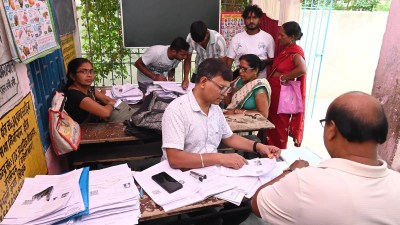3 Indian sites on world fragile monument list
Four Indian sites of key historical and cultural importance have been included in the list of ‘100 most endangered sites-2006’ of ...

Four Indian sites of key historical and cultural importance have been included in the list of ‘100 most endangered sites-2006’ of the World Monuments Fund (WMF). Of the four sites — Dhangkar Gompa in Himachal Pradesh, Guru Lhakhang and Sumda Chung temples in Ladakh, Dalhousie Square in Kolkata and Watson’s Hotel in Mumbai — Dalhousie Square has for the second consecutive time found mention in the list.
In a conversation with The Indian Express over the phone from New York, WMF technical director Mark Webber said: ‘‘Watson’s Hotel in Mumbai — also known as Esplanade Mansion — is the oldest cast iron building in India and we hope its listing (supported by the Kala Ghoda Art District) will spark interest in its restoration.’’
Named after the original owner, John Watson, Watson’s Hotel was fabricated in England and erected onsite between 1867-69. ‘‘Mumbai’s Urban Design Research Institute and the Kala Ghoda Association conducted a feasibility study in 2001 for its restoration. They propose to work with the current owner on the restoration project.’’
WMF is considered the world’s foremost private, non-profit organisation dedicated to the preservation of historic art and architecture. It is funded by private individuals and corporates, with AmericanExpress being its primary corporate funder. ‘‘Sites are listed through applications from stakeholders, of course, supported by the government concerned. However, not all restoration projects are funded by us,’’ said Webber, adding, ‘‘The aim of listing a site is to draw attention to the need for restoration and to encourage awareness about its cultural and historical significance.’’ Since 1996, when the first Indian sites were listed — the Taj Mahal and Jaisalmer Fort were listed in 1996 — over a dozen Indian sites have found mention. ‘‘On occasion, we have worked closely with even the Archaeological Survey of India on restoration projects,’’ Webber pointed out.
Kolkata’s Dalhousie Square, once the epicentre of British colonial power and trade — named in honour of James, Marquis of Dalhousie, Governor General of India from 1847 to 1856 — has been relisted this year. Now, with the help of WMF, the West Bengal government plans to draw out a conservation masterplan for the entire Dalhousie zone.
‘‘For Dhangkar Gompa, the monastery itself was the listing applicant. There are structural problems with the foundation and buttress system of the structure and there is an urgent need to develop a conservation plan in association with the Dhangkar monastic community,’’ said Webber.
‘‘The Namgyal Institute for Research on Ladakhi Art and Culture referred the Guru Lhakhang and Sumda Chung temples to WMF. Built essentially of mud bricks and timber, climate change has posed the primary threat to these temples. We are keen on working out a restoration plan,’’ Webber stated. ‘‘I plan to be in India soon and hope to work on these and other projects with the stakeholders.’’



- 01
- 02
- 03
- 04
- 05




























